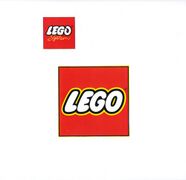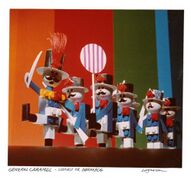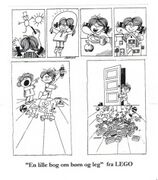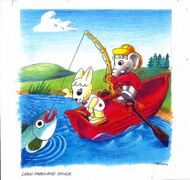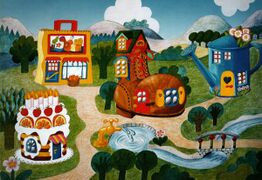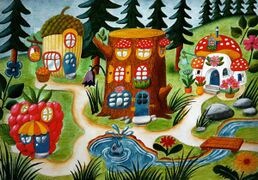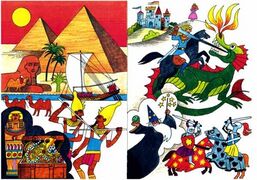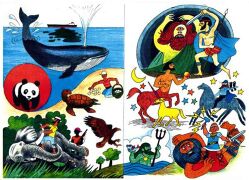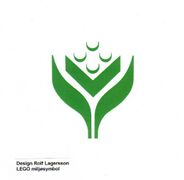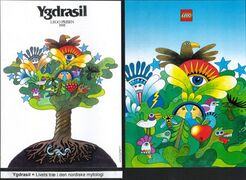Rolf Lagersson: Difference between revisions
I wonder if Rolf's figures had any influence at all on the homemaker figures |
|||
| Line 87: | Line 87: | ||
<ref name="Amstutz">{{cite book |editor-last=Amstutz |editor-first=Walter |year=1962 |url=https://archive.org/details/whoswhoingraphic0000walt/page/432/mode/2up?view=theater |title=Who's Who in Graphic Art |publisher=Amstutz & Herdeg Graphis Press |location=[[Wikipedia:Zurich|Zurich]] |page=433}}</ref> | <ref name="Amstutz">{{cite book |editor-last=Amstutz |editor-first=Walter |year=1962 |url=https://archive.org/details/whoswhoingraphic0000walt/page/432/mode/2up?view=theater |title=Who's Who in Graphic Art |publisher=Amstutz & Herdeg Graphis Press |location=[[Wikipedia:Zurich|Zurich]] |page=433}}</ref> | ||
<ref name="Angrave">{{cite book |last=Angrave |first=Bruce |year=1957 |url=https://archive.org/details/sculptureinpaper0000bruc/page/86/mode/2up?view=theater |title=Sculpture in Paper |publisher=[[Wikipedia:The Studio (magazine)|The Studio Ltd]] |location=[[Wikipedia:London|London]] |pages=86–87}}</ref> | <ref name="Angrave">{{cite book |last=Angrave |first=Bruce |author-link=Wikipedia:Bruce Angrave |year=1957 |url=https://archive.org/details/sculptureinpaper0000bruc/page/86/mode/2up?view=theater |title=Sculpture in Paper |publisher=[[Wikipedia:The Studio (magazine)|The Studio Ltd]] |location=[[Wikipedia:London|London]] |pages=86–87}}</ref> | ||
<ref name="Aynsley">{{cite web |url=https://archive.org/details/centuryofgraphic0000ayns/page/128/mode/2up?q=SAFFT&view=theater |title=A Century of Graphic Design |first=Jeremy |last=Aynsley |publisher=[[Wikipedia:Mitchell Beazley|Mitchell Beazley]] |location=[[Wikipedia:London|London]] |page=128 |ISBN=1-84000-348-0}}</ref> | <ref name="Aynsley">{{cite web |url=https://archive.org/details/centuryofgraphic0000ayns/page/128/mode/2up?q=SAFFT&view=theater |title=A Century of Graphic Design |first=Jeremy |last=Aynsley |publisher=[[Wikipedia:Mitchell Beazley|Mitchell Beazley]] |location=[[Wikipedia:London|London]] |page=128 |ISBN=1-84000-348-0}}</ref> | ||
| Line 131: | Line 131: | ||
<ref name="Superfos interview">{{cite interview |url=http://danishlogo.dk/wp-content/uploads/2018/01/Superfos-Det-nye-Superfos-m%C3%A6rke02.png |title=Et klard design nødvendigt i nutidens kommunikationsjungle |trans-title=A clear design needed in today's communication jungle |language=da |first=Rolf |last=Lagersson |magazine=Mobilia |issue=195 |date=October 1971 |publisher=Mobilia Press ApS |location=[[Wikipedia:Snekkersten|Snekkersten]], Denmark |interviewer=Superfos |archive-url=https://web.archive.org/web/20181106152138/http://danishlogo.dk/wp-content/uploads/2018/01/Superfos-Det-nye-Superfos-m%C3%A6rke02.png |archive-date=2018-11-06 |via=Danish Logo Preservation Society}}</ref> | <ref name="Superfos interview">{{cite interview |url=http://danishlogo.dk/wp-content/uploads/2018/01/Superfos-Det-nye-Superfos-m%C3%A6rke02.png |title=Et klard design nødvendigt i nutidens kommunikationsjungle |trans-title=A clear design needed in today's communication jungle |language=da |first=Rolf |last=Lagersson |magazine=Mobilia |issue=195 |date=October 1971 |publisher=Mobilia Press ApS |location=[[Wikipedia:Snekkersten|Snekkersten]], Denmark |interviewer=Superfos |archive-url=https://web.archive.org/web/20181106152138/http://danishlogo.dk/wp-content/uploads/2018/01/Superfos-Det-nye-Superfos-m%C3%A6rke02.png |archive-date=2018-11-06 |via=Danish Logo Preservation Society}}</ref> | ||
<ref name="Tolkien">{{cite book |url=https://archive.org/details/isbn_9780618391011/page/419/mode/2up?view=theater |title=The J.R.R. Tolkien Companion and Guide – Reader's Guide |first1=Christina |last1=Scull |first2=Wayne G. |last2=Hammond |year=2006 |publisher=[[Wikipedia:Houghton Mifflin Company|Houghton Mifflin Company]] |location=[[Wikipedia:New York City|New York]] |isbn=978-0-618-39101-1 |page=419 |quote=He was no happier with the cover art of the Swedish Fellowship of the Ring (1959): in a draft letter on 14 January 1961, probably to Alina Dadlez, he described it as containing 'pink nudes [which] appear to be fighting some blue nudes of similar shape (in black bathing costumes). Three of the pink nudes are riding horses and have spears; those on foot have axes. Two of the blue men are on oxen; the blues have swords or bows. To what people or incidents in the Tale at any point can this have any conceivable reference?'}}</ref> | <ref name="Tolkien">{{cite book |url=https://archive.org/details/isbn_9780618391011/page/419/mode/2up?view=theater |title=The J.R.R. Tolkien Companion and Guide – Reader's Guide |first1=Christina |last1=Scull |author-link1=Wikipedia:Christina Scull |first2=Wayne G. |last2=Hammond |author-link2=Wikipedia:Wayne G. Hammond |year=2006 |publisher=[[Wikipedia:Houghton Mifflin Company|Houghton Mifflin Company]] |location=[[Wikipedia:New York City|New York]] |isbn=978-0-618-39101-1 |page=419 |quote=He was no happier with the cover art of the Swedish Fellowship of the Ring (1959): in a draft letter on 14 January 1961, probably to Alina Dadlez, he described it as containing 'pink nudes [which] appear to be fighting some blue nudes of similar shape (in black bathing costumes). Three of the pink nudes are riding horses and have spears; those on foot have axes. Two of the blue men are on oxen; the blues have swords or bows. To what people or incidents in the Tale at any point can this have any conceivable reference?'}}</ref> | ||
<ref name="Tryckt till Jul">{{cite web |url=http://tryckttilljul.blogspot.com/2016/09/rolf-lagerson-hog-tid-for-en-man-i.html |title=Rolf Lagerson |first1=Anna |last1=Lindqvist |first2=Marie Odenbring |last2=Widmark |work=Tryckt till Jul |trans-work=Printed for Christmas |language=sv |date=25 September 2016 |archive-url=https://web.archive.org/web/20240731103009/http://tryckttilljul.blogspot.com/2016/09/rolf-lagerson-hog-tid-for-en-man-i.html |archive-date=31 July 2024 |url-status=live}}</ref> | <ref name="Tryckt till Jul">{{cite web |url=http://tryckttilljul.blogspot.com/2016/09/rolf-lagerson-hog-tid-for-en-man-i.html |title=Rolf Lagerson |first1=Anna |last1=Lindqvist |first2=Marie Odenbring |last2=Widmark |work=Tryckt till Jul |trans-work=Printed for Christmas |language=sv |date=25 September 2016 |archive-url=https://web.archive.org/web/20240731103009/http://tryckttilljul.blogspot.com/2016/09/rolf-lagerson-hog-tid-for-en-man-i.html |archive-date=31 July 2024 |url-status=live}}</ref> | ||
Revision as of 02:05, 10 August 2024
Rolf Lagersson | |
|---|---|
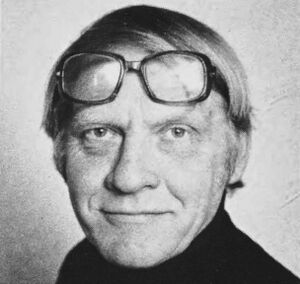 Lagersson in 1988 | |
| Born | Rolf Harald Lagerson 8 January 1925 |
| Died | 9 January 2006 (aged 81) |
| Education | Anders Beckmans Reklamskola |
| Occupations |
|
| Years active | 1948–2003 |
Rolf Harald Lagersson (also spelled Lagerson;[a] 8 January 1925 – 9 January 2006) was a Swedish artist and graphic designer. He was a student of Anders Beckman, and became a well-known figure in Swedish advertising in the 1950s. After living in Sweden for around 40 years, Lagersson moved to Denmark in the mid-1960s and spent another 40 years there.
Lagersson worked with the LEGO Group as a designer for 27 years, creating logos, packaging, catalogue art, and book illustrations; his work for the company includes the 1973 redesign of the LEGO logo. In Sweden, he is best remembered for designing posters and illustrating hundreds of covers for Swedish and Danish books.
Biography
Sweden
Rolf Lagerson was born on 8 January 1925 in Malmö, Skåne.[1] He was the second of three children of Ernst Ragnar Lagersson, an electrical engineer, and Ellen Birgitta "Britta" Strömberg.[2][3][4] He initially studied architecture in 1944, but decided against it and quit to work with a printer before later choosing a career in graphic art. From 1946–1948 he studied in Stockholm at Anders Beckman's school of advertising art[b] and the SGF school of typographical design.[1][6]
For the following six years he worked at several advertising agencies: Gumælius Annonsbyrå in Stockholm from 1948–1950, Benton & Bowles in New York during 1951, and Wilh. Anderssons Annonsbyrå in Stockholm from 1951–1955.[6][7] He also worked at a design agency in Chicago.[8] In 1954 he began working as a freelance artist, operating his own studio in Stockholm from 1955–1965.[1][6] During this decade, Lagerson acted as a consultant art director and designer for various advertising agencies, industrial companies, and publishing houses, as well as Sweden's Ministry of Finance, Ministry of Home Affairs, and Board of Education.[1] Additionally, Lagerson became a founding member of the Swedish Poster Design Association (SAFFT)[c] in 1949, a member of its board in 1954, and the society's president from 1957–1959.[1][10]
Lagerson married Birgitta "Gitt" Hammarberg, a freelance artist and textile designer who had studied fashion at Beckman's school during the time Rolf was also a student there.[11][12] The two had a daughter together, Lotta.[13] In 1965 Gitt and Rolf separated. Rolf moved to Denmark, where he later remarried.[11]
Denmark
In Denmark, Rolf started spelling his last name Lagersson, the same spelling that his father Ragnar had used. During 1966 Lagersson worked at the Copenhagen branch of the Swedish Telegram Agency. In 1967 he began working with Niels Hartmann, a Danish graphic designer who had become a member of Alliance Graphique Internationale that year.[14][15] In 1968 Lagersson once again started operating his own studio, now based in Hørsholm, north of Copenhagen[16] From 1970–1974 Lagersson worked as the creative director at Dot Zero Designgroup, a studio co-owned by the LEGO Group.[17][18] Lagersson moved to Plan Design in 1974 and Papermint Design in 1976, but continued working with the LEGO Group into the 1990s.
In his later years, Lagersson suffered from complications caused by asthma, limiting his ability to work on art.[10] He ceased operating his personal studio at the end of 2003.[16] Lagersson died on 9 January 2006, one day after his 81st birthday.[8]
Works
Rolf Lagersson designed around 300 cover illustrations for books published in Sweden and Denmark.[8] (figure out which ones are notable enough to list) He also created the cover art for the original 1959–1961 Swedish translations of The Lord of the Rings, using stylised illustrations inspired by Greek paintings.[19][20] As well as criticising Åke Ohlmarks's Swedish translation, author J. R. R. Tolkien disapproved of Lagerson's cover for The Fellowship of the Ring, claiming it had nothing to do with the story and describing it as depicting "pink nudes [which] appear to be fighting some blue nudes of similar shape".[21]
Lagerson's work was exhibited in Oslo in 1957, at the Internordic Association of Commercial Artists's (NT) exhibition of advertising art in Stockholm and at the Royal Ontario Museum in Toronto in 1959, and at the Swedish Design Exhibition in Tokyo in 1960.[1] Three works he designed for books are represented at the Nationalmuseum.[8][22] Lagerson won awards in several Swedish competitions between 1949–1958, and won first prize for Internordic Association of Commercial Artists contests in 1956, 1957, and 1959.[1] In 1980 he was awarded the IG Prize for a logo designed for the Danish Cancer Society.[23][24]
Lagerson began creating paper sculptures in 1951, studying from Tadeusz Lipski's 1947 book Paper Sculpture. He later started designing paper dolls that could stand on their own, inspired by the stop motion films of Czech animator Jiří Trnka.[25] Lagerson's dolls had ping-pong balls for heads, conical paper bodies, and flat paper limbs. The dolls were customised with various paper details to create faces, uniforms, and headwear, and placed in sets also made of paper. The full sculptures were intended for use in colour photography. In his 1957 book Sculpture in Paper, Bruce Angrave compared Lagerson's paper doll art to the works of Walter Trier, "with the added excitement of a three-dimensional over-tone".[25] Lagersson later created similar figures for LEGO, replacing the paper bodies with ones made from LEGO elements (see "General Caramel" below).[26][27]
In 1972 Lagersson redesigned the LEGO logo for the LEGO Group.[28][17] The new logo was intended to replace the various previous logos to unify the brand during a time when the LEGO Group was expanding internationally.[29] The new design was based on the previous 1964 LEGO logo, but simplified to only feature the company's name, written in bubble-styled lettering contoured with black and yellow.[29][30] Hartmann intended for the logo to be simple and modular enough that it could be applied anywhere.[15] The new logo was publicly used starting in 1973, eventually receiving a minor redesign in 1998.[29]
Select works
-
LEGO logo, 1972
-
"General Caramel", 1975
-
"En lille bog om børn og leg", 1980
-
Fabuland illustration, 1983
-
Duplo theme concept art, 1988
-
Duplo theme concept art, 1988
-
LEGO theme concept art, 1989
-
LEGO theme concept art, 1989
-
LEGO environmental symbol, 1995
-
Ygdrasil, 1995
-
LEGO packaging, 1971–1997
Illustration bibliography
- Let's play with Lego 1971–72 (LEGO System, 1971) – Art and page layout
- Fabuland set books, with Christina Hartmann: (incomplete, dates uncertain)
- Bonnie Bunny, Otto Davidsen (1983)
- Boris Bulldog, Grete Janus Hertz (1983)
- Edward Elephant (1983/5?)
- Freddy Fox (1983)
- Lionel Lion, Knud Holst (1983)
- Morty Mouse, Esther Jordan (1983)
- The Fancy Dress Party (198?)
- Fabuland story books, with Christina Hartmann unless noted:
- Catherine Cat's Birthday, Nanci Joy Weisbord (Barron's, 1983)
- Henry's Night Out, Nanci Joy Weisbord (Barron's, 1983)
- Morty's New Job, Nanci Joy Weisbord (Barron's, 1983) – with Zdenek Musil
- Billy Bear's Holiday, Virgina Bell (Barron's, 1984)
- Ricky at the Restaurant, Virgina Bell (Barron's, 1984)
- Charlie Cat's Flying Circus, Georgie Adams (Barron's, 1984)
- Lionel Lion's New Car, Georgie Adams (Barron's, 1984)
Notes
- ↑ Although other members of his family used the spelling "Lagersson", Rolf's name was initially spelled "Lagerson". After moving to Denmark in 1965 he began using Lagersson instead. In Swedish sources he remains better known as Lagerson.
- ↑ Template:Lang-sv, renamed to Beckman College of Design (Template:Lang-sv) in 2003.[5]
- ↑ Template:Lang-sv,[9] later ABCD.[10]
References
- ↑ a b c d e f g Amstutz, Walter, ed. (1962). Who's Who in Graphic Art. Zurich: Amstutz & Herdeg Graphis Press. p. 433.
- ↑ Harness, Paul, ed. (1948). "Lagersson, Ernst Ragnar". Vem är Vem? – Skånedelen [Who is Who? Skåne region] (in Swedish). Stockholm: J. O. Peterson. p. 304. Archived from the original on 3 August 2024 – via Project Runeberg.
- ↑ "Avdelningsredaktörer". Svensk uppslagsbok [Swedish reference book] (in Swedish). Vol. 13 (2nd ed.). Malmö: Förlagshuset Norden. 1949. p. vi. Archived from the original on 4 August 2024 – via Project Runeberg.
- ↑ "Ellen Birgitta Lagersson (1897–1984)". Find a Grave. Archived from the original on 2024-08-04. Retrieved 2024-08-04.
- ↑ "Then and now". Beckmans. Archived from the original on 6 May 2024. Retrieved 2 August 2024.
- ↑ a b c Lagerström, Sten, ed. (1966). "Lagerson, Rolf H". Vem är det: svensk biografisk handbok [Who is it: Swedish biographical handbook] (in Swedish) (1967 ed.). Stockholm: Norstedt & Söner. p. 510. Archived from the original on 3 August 2024 – via Project Runeberg.
- ↑ A Directory of Foreign Advertising Agencies and Marketing Research Organizations. Washington, D.C.: U.S. Government Printing Office. April 1959. p. 109. OCLC 1155970.
- ↑ a b c d "About Rolf Lagersson". Rolf Lagersson Billedmager (in Danish). Archived from the original on 26 January 2024. Retrieved 31 July 2024.
- ↑ Aynsley, Jeremy. "A Century of Graphic Design". London: Mitchell Beazley. p. 128. ISBN 1-84000-348-0.
- ↑ a b c Gyllenhoff, Carl (21 January 2006). "Rolf Lagerson". Dagens Nyheter. Stockholm. Off-site copy available here.
- ↑ a b Vagland, Jens; Tjelder, Michael; Londen, Magnus (2015). "Rolf Lagerson". Come to Sweden (in Swedish). Come to Sweden Publishing AB. ISBN 978-91-637-8312-8. Archived from the original on 26 January 2024.
- ↑ Brismo, Karin (1 December 2019). "Juliana i vart hus - Gitt Lindberg Lagerson". designbyBrismo (in Swedish). Archived from the original on 5 August 2024.
- ↑ Lindqvist, Anna; Widmark, Marie Odenbring (25 September 2016). "Rolf Lagerson". Tryckt till Jul [Printed for Christmas] (in Swedish). Archived from the original on 31 July 2024.
- ↑ Uddling, Hans; Paabo, Katrin, eds. (1994). "Lagersson, Rolf H". Vem är det: Svensk biografisk handbok [Who is it: Swedish biographical handbook] (in Swedish) (1995 ed.). Stockholm: Norstedts förlag. p. 628. ISBN 91-1-943202-X. ISSN 0347-3341. Archived from the original on 5 August 2024 – via Project Runeberg.
- ↑ a b "Niels Hartmann, Denmark (1967)". Alliance Graphique Internationale. Archived from the original on 31 July 2024.
- ↑ a b "Rolf Lagersson". Danske selskaber [Danish companies] (in Danish). Archived from the original on 2024-07-31.
- ↑ a b "LEGO". Danish Logo Preservation Society. December 2017. Archived from the original on 2018-02-21.
- ↑ Jönsson, Lena, ed. (1994). "Lagersson, Rolf H". Vem är det: Svensk biografisk handbok [Who is it: Swedish biographical handbook] (in Swedish) (2001 ed.). Stockholm: Norstedt & Söner. p. 650. ISBN 91-7285-042-6. ISSN 0347-3341. Archived from the original on 3 August 2024 – via Project Runeberg.
- ↑ Sundmark, Björn (ed.). "The Translation and Visualization of Tolkien's The Hobbit into Swedish, the Aesthetics of Fantasy, and Tove Jansson's Illustrations". Translating and Transmediating Children's Literature. Cham, Switzerland: Springer Nature Switzerland AG. p. 124. ISBN 978-3-030-52527-9.
The Swedish covers by Rolf Lagerson, both the ones for the first edition 1959–1961 and for the 1967 paperback edition, also work as crossover-illustrations; they represent identifiable scenes and actions from the book, yet they do so in a non-realistic and highly stylized form. The first three (1959–1961) draw inspiration from Greek designs and paintings, while the 1967-set is less stylistically determined.
- ↑ "Bogomslag 2" [Book covers 2]. Rolf Lagersson Billedmager (in Danish). Archived from the original on 26 January 2024. Retrieved 31 July 2024.
- ↑ Scull, Christina; Hammond, Wayne G. (2006). The J.R.R. Tolkien Companion and Guide – Reader's Guide. New York: Houghton Mifflin Company. p. 419. ISBN 978-0-618-39101-1.
He was no happier with the cover art of the Swedish Fellowship of the Ring (1959): in a draft letter on 14 January 1961, probably to Alina Dadlez, he described it as containing 'pink nudes [which] appear to be fighting some blue nudes of similar shape (in black bathing costumes). Three of the pink nudes are riding horses and have spears; those on foot have axes. Two of the blue men are on oxen; the blues have swords or bows. To what people or incidents in the Tale at any point can this have any conceivable reference?'
- ↑ "Rolf Lagerson". Nationalmuseum. Archived from the original on 4 August 2024.
- ↑ Bernsen, Jens; Capetillo, Birgitta, eds. (1988). Profession: Designer. Copenhagen: Dansk Design Center. pp. 90–91. ISBN 87-87385-40-6.
- ↑ Dickson, Thomas (2006). "Grafisk design". Dansk design. Copenhagen: Gyldendal. p. 476. ISBN 978-87-02-07768-1.
Sløjfens facon gav i midten af 1970'eme inspiration til det logo, som Kræftens Bekæmpelse har i dag. Det blev tegnet af grafikeren Rolf Lagersson og tegnestuen Plan Design, der forenklede det gamle mærke til et mere abstrakt symbol for foreningen.
- ↑ a b Angrave, Bruce (1957). Sculpture in Paper. London: The Studio Ltd. pp. 86–87.
- ↑ "Billeder for Børn" [Pictures for Children]. Rolf Lagersson Billedmager (in Danish). Archived from the original on 4 August 2024. Retrieved 8 August 2024.
- ↑ Lagersson, Rolf, ed. (1971). Let's play with Lego 1971–72. Billund: A/S Lego System.
- ↑ "Logos - Symboler" [Logos - Symbols]. Rolf Lagersson Billedmager (in Danish). Archived from the original on 26 January 2024. Retrieved 5 August 2024.
- ↑ a b c Evamy, Michael (2007). Logo (2015 ed.). London: Laurence King Publishing. pp. 152–153. ISBN 978-1-78067-180-2.
- ↑ "A modern, international company – LEGO History". LEGO.com. Archived from the original on 31 July 2024. Retrieved 5 August 2024.
- ↑ Lagersson, Rolf (October 1971). "Et klard design nødvendigt i nutidens kommunikationsjungle" [A clear design needed in today's communication jungle]. Mobilia (Interview) (in Danish). No. 195. Interviewed by Superfos. Snekkersten, Denmark: Mobilia Press ApS. Archived from the original on 2018-11-06 – via Danish Logo Preservation Society.
External links
- Official website (requires flash)
- Rolf Lagerson at Swedish Wikipedia
